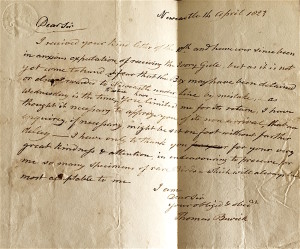 Found -in a reprint copy of Bewick’s A History of British Birds (Newcastle, 1809) a handwritten note pasted at the front endpapers from George Gulliver (anatomist 1804- 1882) stating that the book contains ‘.. 9 proofs of wood cuts of birds, an illustrated receipt, and an autograph letter of Thomas Bewick, dated April 14, 1823 (Newcastle) to Mr L .Edmonston: all inserted at the end of this volume.’ He continues- ‘They were given to me by Mrs Edmonston. Her husband, Dr Laurence Edmondston, has now (1862) been a medical practitioner upwards of 40 years at Bolton Sound, Shetland, which place he is a native. He knew and corresponded with Bewick about birds and the cuts were sent at different times by Bewick to Dr Evanston with the writing on them. George Gulliver. Bewick’s letter is present and reads:
Found -in a reprint copy of Bewick’s A History of British Birds (Newcastle, 1809) a handwritten note pasted at the front endpapers from George Gulliver (anatomist 1804- 1882) stating that the book contains ‘.. 9 proofs of wood cuts of birds, an illustrated receipt, and an autograph letter of Thomas Bewick, dated April 14, 1823 (Newcastle) to Mr L .Edmonston: all inserted at the end of this volume.’ He continues- ‘They were given to me by Mrs Edmonston. Her husband, Dr Laurence Edmondston, has now (1862) been a medical practitioner upwards of 40 years at Bolton Sound, Shetland, which place he is a native. He knew and corresponded with Bewick about birds and the cuts were sent at different times by Bewick to Dr Evanston with the writing on them. George Gulliver. Bewick’s letter is present and reads:
‘Newcastle 14 April 1823. Dear Sir, I received your kind letter of the 10th and have ever since been in anxious expectation of receiving the Ivory Gull, as it’s not yet come to hand. I fear the box may have been detained or else forwarded to Newcastle under Line by mistake as Wednesday is the date which you have limited me for its return. I thought it necessary to apprize you of its non arrival, that an enquiry if necessary might be set on foot without further delay– I have only to thank you for your very great kindness and attention endeavouring to procure from me so many specimens of rare birds which will always be most acceptable to me.I am dear sir your obliged and obedient Thomas Bewick.’ Continue reading


